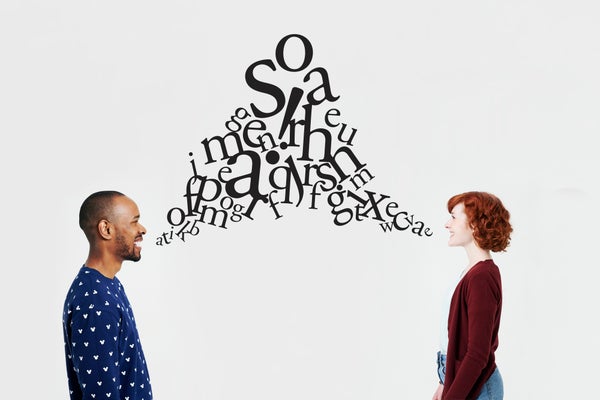In a famous scene from the classic movie Pretty Woman, wealthy businessman Edward Lewis gives Vivian Ward, a Hollywood hooker, a stunning ruby and diamond necklace worth $250,000 to wear out for the evening. At the sight of the necklace, Vivian’s eyes widen and a broad smile lights up her face. Even though it is clear the necklace is only out on loan, Vivian cannot contain her thrill and excitement. Edward, by contrast, displays only the slightest smirk of satisfaction in Vivian’s delight with the jewels.
Movies and television shows are replete with this gender dichotomy in emotional expressiveness, with strong men who say little and reveal even less with their facial expressions (think Dirty Harry, the Duke, Agent Gibbs, Walt Longmire), and equally strong but very expressive women who wear their hearts on their sleeves (think Scarlet O’Hara, Ellen Ripley, Erin Brockovich, Bridget Jones). But is this simply a Hollywood stereotype, or are women in fact more emotionally expressive than men?
New research by McDuff, Kodra, Kaliouby, & LaFrance suggests they are. And they aren’t. Women do smile more than men, and there is evidence that women exaggerate facial expressions for positive emotion. However, McDuff and colleagues believe that smiling and other displays of positive emotion are only part of the picture. Emotions can be negative as well as positive, and within each valence there are a range of distinct emotional states, including fear, disgust, anger, joy, satisfaction, and gratitude.
On supporting science journalism
If you're enjoying this article, consider supporting our award-winning journalism by subscribing. By purchasing a subscription you are helping to ensure the future of impactful stories about the discoveries and ideas shaping our world today.
To explore sex differences in facial expressions across different affective states, McDuff and colleagues developed a unique paradigm for evaluating facial behaviors in response to emotional stimuli. They recruited more than 2000 participants from five different countries to watch advertisements for different, commonly-used products. Participants watched the ads from their own computers, with the understanding that they would be videotaped through their webcams as they viewed. Only participants who felt reasonably comfortable having their reactions recorded were included in the study.
McDuff and colleagues used an automated facial coding system to evaluate the facial expressions of the men and women as they watched the ads. This coding system tied facial behaviors (e.g., smiling) to the movements of specific facial muscles (e.g., contractions of the zygomatic major muscle). Investigators coded smiles, inner and outer brow raises, brow furrows, and lip corner depressors (to see these facial behaviors in isolation, click here). McDuff and colleagues measured not only the frequency of different expressions, but their durations as well.
In some ways, the results from this study confirm previous findings of greater emotional expressiveness for women. Women did smile more often than men in response to the ads, and their smiles were longer in duration. They also engaged in more inner brow raises, though the duration of these brow raises did not differ from that of men. These data not only align with the belief that women are more likely than men to display emotion, but also suggest that this tendency extends to negative as well as positive emotions, as inner brow raises are thought to be reflective of states of fear and sadness.
In other ways, however, the data from McDuff and colleagues suggest a more nuanced account of sex differences in expressiveness. Women were not universally more expressive than men, as men were more likely to demonstrate anger-based facial behaviors than women. Men showed more brow furrowing than women, and their brow furrows were longer than those of women as well. In addition, lip corner depressors were significantly longer in men than in women.
This pattern of findings, with women expressing more happiness and sadness, and men expressing more anger, could reflect social conventions about gender-appropriate behavior. If so, these conventions seem to hold across several different cultures, as the general pattern of findings was consistent across the five countries (US, Germany, UK, China, France) included in the study. Although the magnitude of the sex differences varied somewhat across cultures (e.g., women smiled reliably more than men in Germany, the UK and the US but not France or China), the directionality of the data were the same regardless of the country.
McDuff’s paradigm offers a number of advantages over some of the previous lab-based paradigms used to evaluate facial expressions. First, the researchers included a very large sample. McDuff and colleagues tested ten times the number of participants than are tested in a typical laboratory study, lending confidence that the sex differences observed here are reflective of those in the general population. Second, this study assessed facial expressions made in response to naturalistic stimuli in everyday settings, further increasing the generalizability of the findings. Third, researchers collected data from five countries, enabling a cross-cultural comparison of emotional expressiveness.
Despite these advantages, there are still more questions to be answered. Are women and men relatively more expressive for happiness and anger, respectively, because they experience these emotions more intensely? Unfortunately, participants did not report their internal emotional reactions to the ads, and so there is no way to make a direct connection between facial expression and emotional experience. In addition, because the researchers focused on facial behaviors rather than distinct internal emotional states, little is known about sex differences in reactions to specific states like disgust, hope, or gratitude. As scientists further pursue these questions, we can be fairly confident in one thing: Despite Hollywood portrayals, women are not universally expressive and men are not consistently stoic. Instead, the intensity of the reaction is likely to depend not only on the sex of the individual but also on the specific emotional state.

